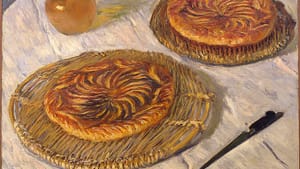Stay in the Loop
BSR publishes on a weekly schedule, with an email newsletter every Wednesday and Thursday morning. There’s no paywall, and subscribing is always free.
A triumph of didacticism and delectation
Paul Durand-Ruel and Impressionism (second review)

My first reaction to the news last year the Philadelphia Museum of Art would be mounting a major exhibition of the Impressionists this spring was that the last thing we need is another damn Impressionist show.
I was wrong, terribly wrong.
Discovering the Impressionists revolves around Paul Durand-Ruel, the prescient and shrewd Parisian dealer who championed, promoted, bought, and sold thousands of works by the Impressionists. His acuity and vision is attested to by the wondrous collection of paintings seen here, many for the first time in the United States and some for the first time together in more than a century.
The wall labels require as much scrutiny as the art itself. On each we learn not only the year in which the painting was executed, but also the year it was first acquired by Durand-Ruel, to whom it was sold or auctioned, and, sometimes, the year it was reacquired and resold — often by Durand-Ruel. The last entry names the current institution or individual who owns the work and from whom it was acquired.
The give and take of buying and selling
Included among the artifacts of the exhibition is Durand-Ruel’s ledger, which lists, among its many columns, the asking and selling prices for each work he handled.
Audiences today are generally well aware of the role that major galleries and private dealers play, not just in the success of individual artists but in the prices realized for their work. Indeed, beginning in the mid-20th century, dealers became celebrities themselves; in some cases, they became the subject of works. This exhibition successfully limns not only the triumphs of the relationship between a dealer and his stable, but also its pitfalls and failures.
Durand-Ruel took risks in championing artists who were unknown or unpopular at the time. He never doubted the revolutionary qualities of their work, but he was faced with hostile or indifferent audiences and skeptical collectors. He employed — often for the first time — all the strategies with which we are now familiar: bidding on his own artists’ works at auction to prop up the prices; purchasing paintings in bulk from each artist, sometimes before all of them were even executed; and prodding his artists on aesthetic grounds.
Art on speculation
Durand-Ruel would often visit an artist’s studio and buy 25 to 30 paintings or more on the spot. Needless to say, these purchases (or advances he would make for future works) were entirely speculative. Monet’s 1883 exhibition of roughly 60 paintings was a complete failure — nothing sold. By 1892, Durand-Ruel exhibited Monet’s Poplars and all of them sold.
Durand-Ruel flirted with or went through bankruptcies. He purchased works in collaboration with other dealers. He borrowed heavily. He opened galleries in other European capitals and in New York. He traveled ceaselessly in support of his artists. Indeed, he first met Monet and Pissarro in London, where they and others had fled to escape the Franco-Prussian War.
The Impressionists’ first major exhibition as a group was in 1874. Two years later, they mounted their second important group show at Durand-Ruel’s gallery in Paris. It was not a commercial success. The first major commercial success from a show came in New York, not Paris — an 1886 exhibition at the American Art Galleries in New York was well received. A second exhibition followed immediately at the National Academy of Design in New York. Buoyed by the positive experiences in New York, including sales to a number of important American collectors (many of whom are represented on the wall labels of this exhibition), Durand-Ruel returned to Paris, where future exhibitions, including the Monet show of Poplars, were both critical and financial successes.
Luck of “discovery”
This exhibit is not simply about the making of reputations and the business of art. Durand-Ruel can be said to have discovered, as well as championed, these artists, but had he not, someone else would have come along — the art is wonderful. Many of the paintings that fill the exhibit’s walls were unknown to me, even in reproduction; others I was seeing in person for the first time. All of them confirmed their original champion's intuition.
For Steve Cohen’s review of the exhibit, click here.
What, When, Where
Discovering the Impressionists: Paul Durand-Ruel and the New Painting. A joint project of the Philadelphia Museum of Art, Réunion des musées nationaux-Grand Palais and Musée d'Orsay in Paris, and the National Gallery in London. Through September 13 at the Philadelphia Museum of Art, 2600 Benjamin Franklin Pkwy., Philadelphia. 215-763-8100 or philamuseum.org.
Sign up for our newsletter
All of the week's new articles, all in one place. Sign up for the free weekly BSR newsletters, and don't miss a conversation.
